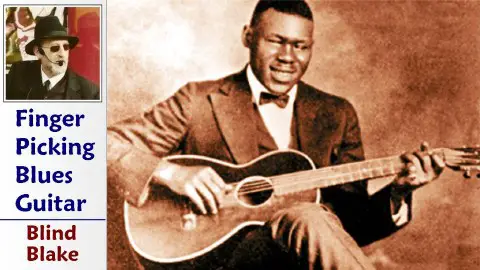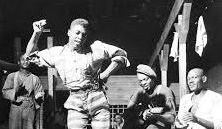The Ragtime Blues Guitar Style Of Blind Blake

When I initially heard ragtime guitar, I believed that this complicated sound was being definitely created by at least 2 instruments.
Even though using the exact same fundamental finger and thumb motions that we discover in any tune or song utilizing an alternating bass pattern, the outcome is really quite different from folk picking, for instance.
Ragtime guitar was my great love more than forty five years and this interest ultimately caused me to explore in detail the strategies utilized by the first ragtime blues guitarists.
This is very important for a few reasons. These men handed down to us a big tradition of blues from the roots that definitely should not be overlooked.
Even when we develop our own unique music and songs, at a minimum of we ought to attempt to keep some of that initial passion and pay tribute to the Gurus.
For my own part, it helps my playing to attempt to get into the consciousness of somebody that performed (and developed) the blues, in some cases performing for nickels and pennies on the streets, or for a square meal and a pallet on the floor.
These people really did not simply play the blues, it was integral to their very existence - they were really the Blues personified!
The music and songs was an interpretation of their experiences, regardless of whether it was a sad and mournful bottleneck composition from the Mississippi Delta, or the delightful dancing sound that ended up being referred to as Ragtime.
 Ragtime piano evolved from an unique blend of classical and jazz piano designs and Scott Joplin was it's shining light. Among the striking attributes of the sound was a solid jumping bass line, which moves in between the piano keys in a type of a 'bum-chick, bum-chick' noise.
Ragtime piano evolved from an unique blend of classical and jazz piano designs and Scott Joplin was it's shining light. Among the striking attributes of the sound was a solid jumping bass line, which moves in between the piano keys in a type of a 'bum-chick, bum-chick' noise. The very first blues guitar music most likely utilized a very basic bass pattern - frequently simply 1 string was hit with the thumb prior to muting the note perspiring, or choking the vibration off, with the side of the picking hand.
This is often referred to as the 'monotonic bass' approach to picking guitar.
This solitary thumb strike method of playing generated a 'thunk' instead of a tidy note, and provided a strong drum-like rhythm to blues songs. The bass string was damped a lot, so much so that the real pro players often didn't bother to fret the bass strings for many of the basic chord shapes.
That isn't to state that of the songs created were easy simplified bass pattern help in getting more innovative with their melodies when creating patterns for the higher strings.
And so, exactly how did these very first ragtime guitarist aim to make their instruments seem like a piano?
Eventually, a clever young guitar player suddenly saw that the 'bum-chick' piano pattern might be created on a 6 string guitar by hitting 2 or 3 bass strings using the thumb and alternating the strikes across the strings - ragtime blues guitar was given birth!
Ever since that time, the alternating bass type of finger-style guitar has actually ended up being the prevalent style in lots of music styles and modern-day pickers have really refined the method into an art form.
FINGERPICKING GUITAR LIKE BLIND BLAKE
Blake was definitely the wizard of the 'syncopated bass' and utilized a range of methods to obtain that attractive sound.
It is entirely possible to explain syncopation in specialized terms and show the effects of accentuating the off-beats, however a helpful explanation might be that the hearer is pleasantly surprised by modifications in the tempo and tune that typically aren't anticipated.
Blake definitely accomplishes this with a rapidity and precision that continue to excite to this day. Soon after showing up in Chicago from his native Florida, the regional blues men would have been astonished by his impressive virtuosity, and he sang at the exact same time!
Oddly enough, his most famous work of art that numerous acoustic blues guitar players aim to duplicate is entitled West Coast Blues, which happened to be the very first record he ever cut and integrates his popular 'thumb roll ' or 'thumb stumble' technique.
It is performed in the key of C (although I utilize a capo in the video listed below) and the chords are absolutely nothing elegant, simply a basic development C, E7, A7, D7 and G7.
There are no elegant inversions, although the real chord moves are quick and typically integrate additional notes in the greater variety to include intricacy. The genuine magic is the method which Blake performs the alternating bass line with his thumb.
Basically, his thumb slips from one bass string to another, thus creating two notes for each beat rather of one. He didn't do this for every single thumb strike, which would make it a bit uninteresting and a bit of a cliche. The outcome is an intricate sounding syncopation that is extremely hard to copy consistently.
The tablature listed below demonstrate how it looks for a C chord:

The video embedded below shows how it is accomplished and includes guitar tab overlays to show the strategy.
To play it right, the skin is sure to rub against the strings again and again, therefore your thumb will certainly be very sore for a week or two!
Just as if it had not been more than enough to master that dual thumb movement, the bass strings have to be choked, or muted, with the side of the finger-picking hand. In the event that you let the strings sound out, it has the tendency to be a little bit of a mess and may be jarring to the ear.
Actually, string muting may be achieved with either hand, except if the string in concern is being picked without being fretted, so the fretting hand should be utilized, just by letting go of the string a touch and then applying the pressure before the note really begins to sound out.
Any student guitar player would benefit from applying the lessons of the old blues guys.
Author: Jim Bruce
Date: 2013-10-01
Category: Music
Useful Links:
https://plus.google.com/u/0/+JimBruceGuitarLessons

